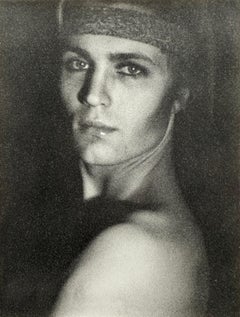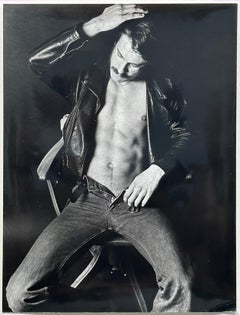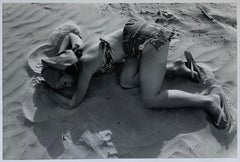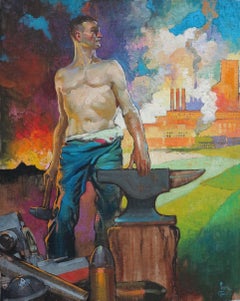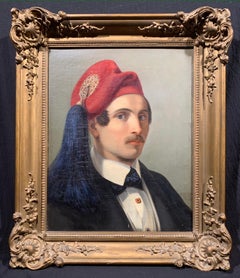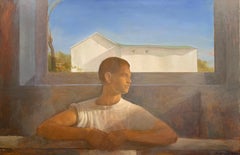Randall Exon (b.1956). Matthew, 1990. Oil on wood panel. Measures 24 x 36 inches. Unframed. Excellent condition with no damage or conservation. Signed and dated lower right. Gallery stamp on verso. Plastic wall mount taped down on verso.
Provenance: The More Gallery INC, Philadelphia; Aramark Corporate Collection.
Randall Exon (b. 1956) was born in Vermillion, South Dakota. Exon earned his B.F.A. in painting from Washburn University in Topeka, Kansas, and an M.F.A. at the University of Iowa. In 2003, the James A. Michener Art Museum in Doylestown, Pennsylvania, staged a solo exhibition of his work. He was awarded the Thomas Benedict Clarke Prize in the 2004 179th Annual Invitation Exhibition of Contemporary American Art at the National Academy Museum and School of Fine Arts, New York. More recently, Exon’s work was featured in Visions of the Susquehanna, a traveling exhibition organized by the Lancaster Museum of Art, Pennsylvania, in 2008, and Haunting Narratives, a major exhibition at the Woodmere Art Museum, Philadelphia, in 2012.
BORN
1956 Vermillion, SD
EDUCATION
1982 M.F.A. in Painting, University of Iowa, Iowa City, IA 1981 Skowhegan School of Painting, Skowhegan, ME 1981 M.A. in Painting, University of Iowa, Iowa City, IA 1978 B.F.A. in Painting, Washburn University, Topeka, KS
SOLO EXHIBITIONS
2013 Hirschl & Adler Modern, New York, NY
2009 Hirschl & Adler Modern, New York, NY
2007 Hirschl & Adler Modern, New York, NY
2004 Hirschl & Adler Modern, New York, NY
2003 Randall Exon: A Quiet Light, James A. Michener Art Museum,
Doylestown, PA
2001 Mulvane Museum of Art, Topeka, KS
2000 More Gallery, Philadelphia, PA
1998 More Gallery, Philadelphia, PA
1996 More Gallery, Philadelphia, PA
1994 More Gallery, Philadelphia, PA
1993 Tasis England American School, Main Gallery, Thorpe, Surrey, England 1992 More Gallery, Philadelphia, PA
Theatre Gallery, Washburn University, Topeka, KS
Widener University Art Museum, Chester, PA 1990 Charles More Gallery, Philadelphia, PA
1988 West Chester University, McKinney Gallery, Mitchell Hall, West Chester, PA Charles More Gallery, Philadelphia, PA
Carleton College, Northfield, MN
1987 University of Maine at Machias, University Gallery, ME
Topeka Public Library, Central Gallery, KS 1986 More Gallery, Philadelphia, PA
1984 More Gallery, Philadelphia, PA
Stoneybrook School, Suffolk, Long Island, NY
1981-82 Florence Wilcox Gallery, Swarthmore College, PA Beauchamp Gallery, Topeka, KS
SELECTED GROUP EXHIBITIONS
2019 Unforeseeable Thereness, Stanek Gallery, Philadelphia, PA
2018 Vis-à-Vis, Hirschl & Adler Galleries, New York, NY
2017 The New Baroque, Booth Gallery, New York, NY, curated by Robert
Zeller
Painted Landscapes: Contemporary Views, Heritage Museums and Gardens, Sandwich, MA
2016 Mixed Environs: Contemporary Painters, Lore Degenstein Gallery, Susquehanna University, Selinsgrove, PA
2015 Home is Where the Art Is, Hirschl & Adler Galleries, New York, NY 2014 Our American Life, Hirschl & Adler Galleries, New York, NY
2014 Edge of the Seat, The Rye Arts Center Gallery, Rye, NY
2013 Duets: Art in Conversation, Hirschl & Adler Galleries, New York, NY 2012 Haunting Narratives: Detours from Philadelphia Realism, 1935-Present,
Woodmere Art Museum, Philadelphia, PA
Structuring Nature, Walton Arts Center, Fayetteville, AR Summer Selections, Hirschl & Adler Modern, New York, NY
2011 Masterworks: The Best of Hirschl & Adler, Hirschl & Adler Galleries, New York, NY
2010 Summer Selections, Hirschl & Adler Modern, New York, NY
2009 Holiday Selections, Hirschl & Adler Modern, New York, NY
2008-2009 American Green – Art and Stewardship, Somerville-Manning Gallery, Greenville,
DE
2008 Holiday Selections, Hirschl & Adler Modern, New York, NY
Summer Selections, Hirschl & Adler Modern, New York, NY 2007 Finding a Form: Influences in Figurative Painting, Tower Gallery,
Philadelphia, PA
Holiday Selections, Hirschl & Adler Modern, New York, NY Summer Selections, Hirschl & Adler Modern, New York, NY
2006-2008 Visions of the Susquehanna, Susquehanna Art Museum, PA; Governor’s Residence, Harrisburgh, PA; Washington County Museum of Fine Arts, Hagerstown, MD; Roberson Center for Art and Science, Binghamton, NY.
2006 Summer Selections, Hirschl & Adler Modern, New York, NY
2004 179th Annual: An Invitational Exhibition of Contemporary American Art,
National Academy of Design, New York, NY
Selected Works from the Ballinglen Collection, United States Embassy to Ireland, Ambassadors Residence, Phoenix Park, Dublin, Republic of Ireland. Part of the Art in the Embassies Program, Washington D.C.
2001 Personal Affinities, Contemporary Artists Influenced by the works of Edwin Dickinson, Pennsylvania Academy of the Fine Arts Museum, Philadelphia, PA
2000 December Show, Fenton Gallery, Cork City, Ireland
Works from the Archives, Ballinglen Arts Foundation, Ballycastle, County Mayo, Ireland
1999 New Realism for a New Millennium, Memorial Art Gallery, University of Rochester, NY
Indomitable Spirits, The Figure At The End Of The Century, The Art Institute of
Southern California, Laguna Beach, CA
1998 Visual Poetry, A Selection of Work by Artists Inspired by the Words and
Sentiments of Walt Whitman, Stedman Gallery, Rutgers University, Camden, NJ The Artist's Window, Lee Hansley Gallery, Raleigh, NC
Embodied Fictions, Twelve Contemporary Figure Painters, The Boyden Gallery, St. Mary's College of Maryland, St. Mary’s City, MD
1997 Abstract and Image, Four Painters, Hopkin's Center, Dartmouth College, Hanover, NH
An Extended View: Landscapes by Philadelphia Artists, Levy and Paley Galleries,
Moore College of Art and Design, Philadelphia, PA
1996 Figure Drawings, Hillyer Hall, Smith College, Northampton, MA
Figurative Paintings, Edith Caldwell Gallery, San Francisco, CA
A Show of Hands (Exhibit and auction to assist AIDS research), Moore College of Art and Design, Philadelphia, PA
1994 Figures in the Landscape, More Gallery, Philadelphia, PA
1992 Landscapes by Randall Exon & Joseph Byrne, Dartmouth College, Hanover, NH 1991 A Show of Hands, Moore College of Art and Design, Philadelphia, PA
1991 Ten Contemporary Philadelphia Painters, Westmoreland Museum, Greensburg, PA 1991 Sport in Art, Woodmere Museum, Chestnut Hill, PA
1990 Myth and Monument, More Gallery, Philadelphia, PA
1990 Evidence of the Senses, 7 Painters, Woodmere Museum, Chestnut Hill, PA
Pollack Award Winners, Mulvane Gallery, Washburn University, Topeka, KS 1989 Works on Paper, More Gallery, Philadelphia, PA
Nocturnes, More Gallery, Philadelphia, PA
1986 Nature Morte, Southern Alleghenies Museum of Art, St. Francis College, Loretto, PA 1984 The Spirit of the Coast: Paintings, Monmouth Museum, NJ
Drawings: Personal and Intimate, More Gallery, Philadelphia, PA
Night Paintings, Florence Wilcox Gallery, Swarthmore, PA
1983 Realist Direction, Penn State University Museum, University Park, PA 1981 Graduate Student Traveling Exhibit, University of Iowa, Iowa City, IA 1980 Selected Painters, Mulvane Gallery, Washburn University, Topeka, KS 1979 Artists Choose Artists Exhibit, University of Missouri at Kansas City Art
Gallery, MO
JURIED SHOWS
1990 Philadelphia Art Now, Philadelphia Museum of Art, PA
1989 State of Pennsylvania Juried Exhibition, William Penn Museum, Harrisburg, PA 1987 State of Pennsylvania Juried Exhibition, William Penn Museum, Harrisburg, PA 1984 Butler Institute of American Art Annual Exhibit, Youngstown, OH
National Academy of Design Biannual Competition, New York, NY 1981 32nd Iowa Artists Exhibition, Des Moines Art Center, Des Moines, IA 1980 Iowa Artists Solon, Burnnier Gallery, Iowa State University, Ames, IA 1979 Kansas Bankers Association Exhibition, Topeka, KS
AWARDS/GRANTS/RESIDENCIES
2004 The Thomas Benedict Clarke Prize, 179th Annual Invitational Exhibition of Contemporary American Art, National Academy Museum and School of Fine Arts, New York, NY
2001 2nd Fellowship, Ballinglen Arts Foundation, Ballycastle, County Mayo, Ireland Eugene M. Lang Faculty Fellowship, Swarthmore College, PA
1997 Fellow, Ballinglen Arts Foundation, Ballycastle, County Mayo, Ireland 1992 Washburn Fellow, Washburn University, Topeka, KS
1989 Eugene M. Lang Faculty Fellowship, Swarthmore College, PA
1988 Andrew Carnegie Prize, 163rd Annual Exhibition of the National
Academy of Design, New York, NY 1987
1985-86 1984
1981 1981 1980 1976, 78
TEACHING
1982-present 1994-00 1980-82
Best of Show prize, juried museum exhibition, The State Museum of Pennsylvania, Harrisburg, PA
Henry Luce Scholar, Bali, Indonesia
Julius Halgarten Prize for Best Painting by an Artist under 35 years of age Academy of Design Annual Exhibition, New York, NY
Iowa Artists Salon, Second Prize
Skowhegan Scholarship Award, University of Iowa, Iowa City, IA
Student Award, 32nd Iowa Artists Exhibition, Des Moines Art Center, IA
Charles Pollack purchase prize for the best painting from annual student exhibition, Washburn University, Topeka, KS
Professor in Studio Arts, Swarthmore College, Swarthmore, PA
Chair, Department of Art, Swarthmore College, Swarthmore, PA Teaching Assistant to Ben Frank Moss, University of Iowa, Iowa City, IA
VISITING ARTIST/LECTURES
2002 2001
1998 1995
1994 1993
1994, 1992 1992
1989
1987
1986 1985
1982
Pennsylvania State University, Abington, PA Hollins College, Roanoke, VA
Maryland Arts Institute, Baltimore, MD Beaver College, Glenside, PA
Union College, Department of Art, Schenectady, NY Allentown Art Museum, PA
Pennsylvania Academy of the Fine Arts, Philadelphia, PA Bucks County Community College, Newtown, PA
Tasis England American School, Thorpe, Surrey, England Boston Art Institute, MA
Boston University, M.F.A. program, MA
Beaver College, Department of Art, Philadelphia, PA
Dartmouth College, Department of Visual Studies, Hanover, NH Dartmouth College, Department of Visual Studies, Hanover, NH Carleton College, Northfield, MN
University of Maine at Machias, ME
Horsham College of Art, Horsham, England Stoneybrook School, Suffolk, Long Island, NY
Moore College of Art, Basic Drawing, Philadelphia, PA Vassar College, Department of Art, Poughkeepsie, NY
PUBLIC COLLECTIONS
Allentown Art Museum, PA
ARA Corporation, Philadelphia, PA
Security Pacific National Bank, Sanger Branch, Los Angeles, CA University of Iowa, Permanent Collection, Iowa City, IA
Mulvane Gallery Permanent Collection, Washburn University, Topeka, KS Woodmere Museum, Mt. Airy, Philadelphia, PA
Henry Luce Foundation, New York, NY
Henry Wendt Collection, Philadelphia, PA
Susquehanna Art Museum, Harrisburg, PA
SELECTED BIBLIOGRAPHY
Sozanski, Edward J. “Simple Situations, in almost holy light,” Philadelphia Inquirer , February 7, 2003
Francis, Naila,“Studies in Light, Space,” The Intelligencer, January 9, 2003
Thompson, Jodi, “Fabulous Realism, seeing the light,” Out & About, January 9, 2003
Hopkin, Alannah, The Irish Examiner, July 1, 2002
Hopkin, Alannah, The Irish Examiner, January 2002
Sosanski, Edward, Philadelphia Inquirer, February 2001
Carr, Jeffrey, “Landscapes of the Imagination,” American Artist, January 1999
“On The Town,” New York Times Art Review, November 1998
Adelson,
Fred B...
